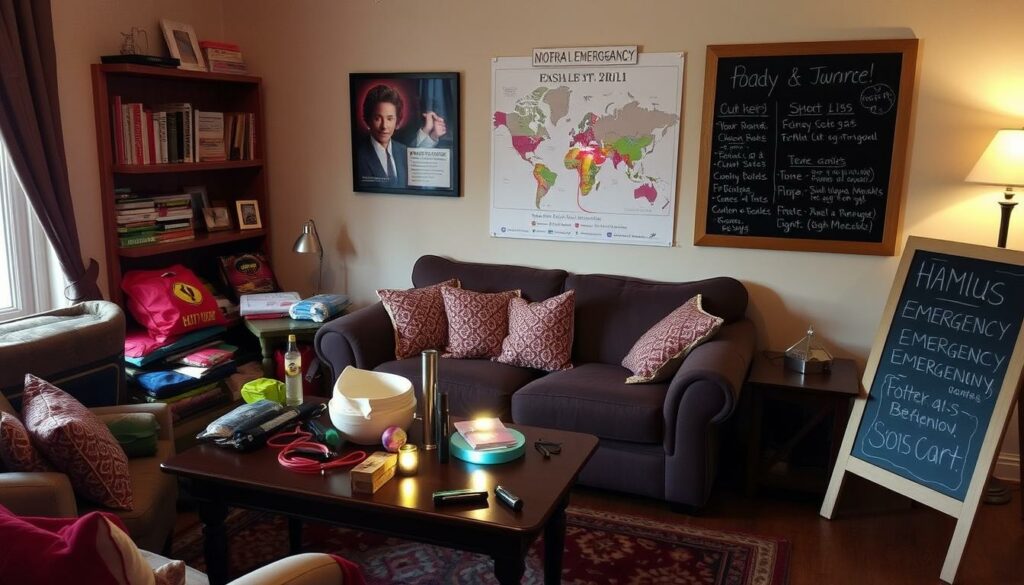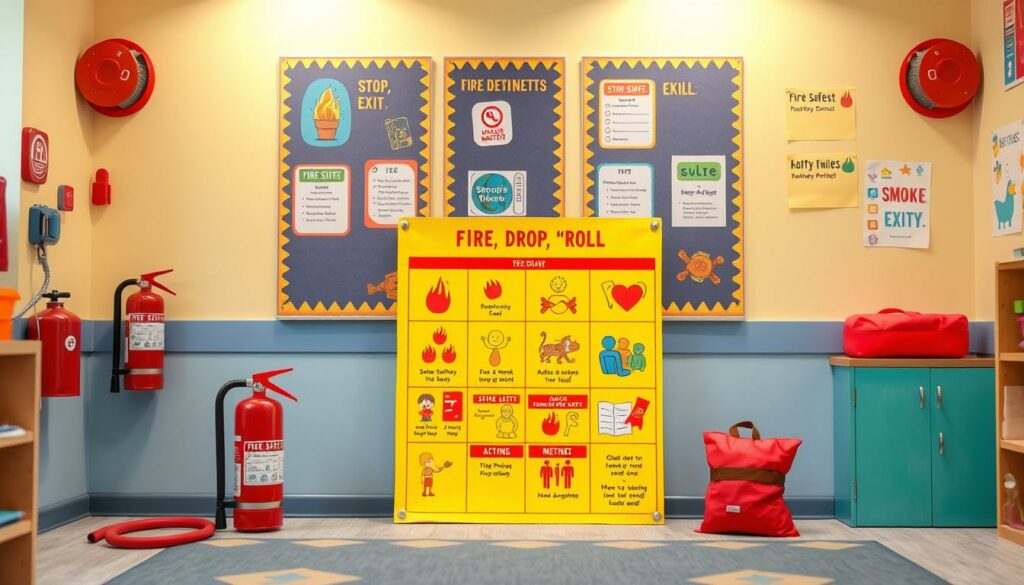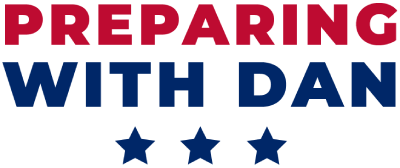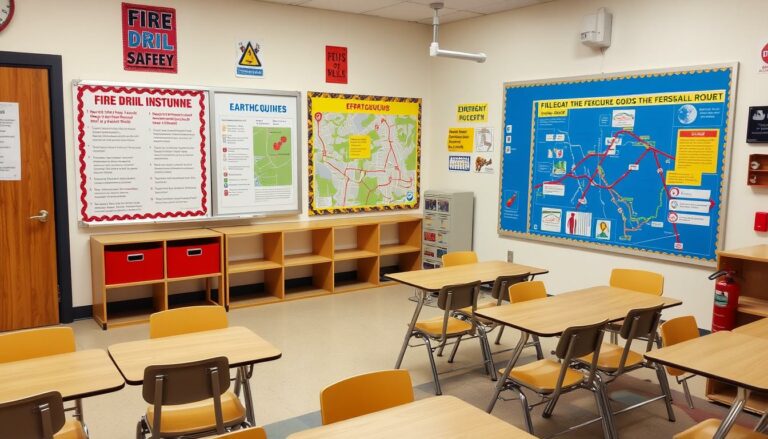Emergency drills for kids are key for family safety. They teach both kids and adults what to do in danger. Knowing what to do in fires or earthquakes can save lives. Let’s see how to make these drills fun and useful for families.
Schools are important in teaching kids about safety. They practice drills to leave buildings fast and safely. These drills make sure all kids, including those who need extra help, are counted.
But it’s not just about the steps. These drills help our minds stay calm in real emergencies. That’s why practicing often and taking it seriously is crucial. The more we practice, the better we’ll act when it matters most.
Key Takeaways
- Regular drills improve safety skills for both kids and adults
- Schools use different types of drills to prepare for various emergencies
- Practice helps keep our brains calm in real emergencies
- All children, including those with special needs, should be included in drills
- Family emergency practice at home reinforces school safety lessons
- Keeping a positive attitude during drills helps reduce fear in children
Understanding the Importance of Emergency Drills for Children
Being ready for emergencies is crucial for keeping families safe. Family emergency drills and child safety exercises are key. They help build confidence and skills for handling emergencies well.
Why emergency preparedness matters for families
Families might face many emergencies, like natural disasters or accidents. Being ready can greatly improve how well children deal with these events. Research shows that 85% of kids feel safer when they know what to do in emergencies.
The role of practice in building confidence and skills
Doing emergency drills often helps kids learn important skills and feel more confident. In fact, 72% of kids say they’re less scared in real emergencies after practicing. These drills teach kids about safety steps and how to stay calm when it matters.
Balancing preparation with age-appropriate information
Talking to kids about emergencies needs to be done right. Use easy words and focus on what kids can do to help. More than 90% of kids do better with calm drills. It’s important to say emergencies don’t happen often but being ready is key.
“Preparedness is not about scaring children, but empowering them with knowledge and skills to stay safe.”
Adding family emergency drills and child safety exercises to your routine helps your kids gain important life skills. It also builds a sense of security that helps them throughout their lives.
Types of Emergency Drills Families Should Practice
Families must be prepared for different emergencies. Practicing emergency drills is key to building important skills. Let’s look at the main drills every family should do often.
Fire drills are a must. For homes with two stories, keep fire ladders upstairs. Teach kids about smoke detectors and how to use fire extinguishers. KinderCare Learning Centers do fire and disaster drills every month, showing families how it’s done.
Natural disaster drills are also crucial, even if you’re not in a high-risk area. Practice “drop, cover, and hold on” for earthquakes. For tornadoes, know where to go in your home for safety. These drills help kids remember what to do in real emergencies.
Lockdown drills are now very important. In 2015/16, 95% of U.S. public schools did lockdown drills. Families can also practice these at home, teaching kids to be quiet and hidden.
| Drill Type | Key Actions | Practice Frequency |
|---|---|---|
| Fire Drill | Use fire ladders, check smoke detectors | Monthly |
| Earthquake Drill | Drop, cover, hold on | Quarterly |
| Tornado Drill | Move to safe space | Seasonally |
| Lockdown Drill | Stay quiet, hide | Twice a year |
Practicing these drills often can really help in emergencies. Make sure drills are fun and right for your kids’ age. This way, your family will be ready and confident in any situation.
Creating a Family Emergency Communication Plan
A solid family emergency communication plan is key for keeping kids safe. It makes sure everyone knows what to do and how to stay in touch during emergencies.
Establishing Meeting Places and Out-of-State Contacts
Choose two meeting spots for your family. One should be near home for quick evacuations, and another far from your area if you can’t go back. Also, pick an out-of-state contact for your family’s emergency check-ins.
Utilizing Emergency Notification Apps and Tools
Modern tech has great tools for staying connected. Use apps like the American Red Cross Disaster apps for alerts and updates. These apps can be very helpful when phone lines are busy.

Teaching Children Emergency Contact Information
Make sure your kids know important phone numbers by heart. Practice saying these numbers during drills. For school-age kids, use the CDC’s “Backpack Emergency Card” to keep important info close.
Update your plan every year or when family details change. Regular practice keeps everyone ready and confident in emergencies.
| Communication Method | Advantages | Usage Tips |
|---|---|---|
| Text Messages | Requires less bandwidth than calls | Use for quick check-ins |
| Phone Calls | Direct communication | Wait 10 seconds before redialing |
| Emergency Apps | Instant alerts and updates | Keep devices charged |
Building an Age-Appropriate Emergency Supply Kit
Creating an emergency supply kit is key to getting your family ready for the unexpected. For child safety drills, having the right supplies is crucial. Let’s see how to make a kit that fits your family’s needs.
Begin with the basics. FEMA recommends storing one gallon of water per person for at least three days. Include non-perishable food that your kids like. And remember to pack special items for babies, like formula and diapers.
Don’t forget essential tools like a flashlight, battery-powered radio, and extra batteries. These help you stay informed when the power goes out. Also, include personal hygiene items, such as moist towelettes and hand sanitizer.
- First aid kit and prescription medications
- Dust masks and plastic sheeting for shelter
- Important family documents in a waterproof container
- Books, games, and puzzles to keep children entertained
Get your children involved in packing the kit. It’s a fun way to teach them about emergency drills. Let them pick comfort items like stuffed animals or favorite snacks. Keep your kit in an easy spot and check it often to replace expired items.
“A well-prepared family is a safer family. Emergency kits give peace of mind and empower children to face unexpected situations with confidence.”
Your emergency kit should grow with your family. Update it as your children’s needs change. By involving kids in this process, you’re not just preparing for emergencies. You’re teaching them valuable life skills and boosting their confidence in unexpected situations.
Emergency Drills for Children: Making Practice Fun and Engaging
Child safety drills don’t have to be scary or boring. With creativity, we can turn these important lessons into fun emergency drills. Kids will enjoy and remember them. Let’s look at some ways to make them fun.
Games and Activities for Drill Practice
Make safety lessons exciting with games. Play “Exit Finders” to help kids spot escape routes. Use hopscotch to teach them the 911 number. These games make learning fun and help them remember better.
Positive Reinforcement and Rewards
Praise kids for joining in on drills. Give them small rewards for remembering safety steps. This makes them more active and builds their confidence in emergencies.
Memorable Safety Phrases and Songs
Create catchy phrases like “Hot, hot, stay away. Hot, hot, not for play!” for fire safety. Sing songs about “Stop, Drop, and Roll.” These tunes help kids remember important steps during emergencies.
Use pretend play with safety themes. Set up a mini fire station or hospital corner. Read safety-themed books to start discussions. These activities make safety drills a fun part of playtime, preparing kids well without making them feel scared.
“Teaching preschoolers about safety is as important as early science, math, and literacy skills.”
By making emergency preparedness fun, we help kids learn important skills while keeping them happy. These interactive safety drills create a positive view of being ready for emergencies. This sets a strong foundation for safety awareness throughout their lives.
Fire Safety Skills for Young Children
Teaching fire safety skills is key for keeping kids safe. They need to know how to act in emergencies. Let’s look at important skills to help children during fires.

It’s crucial to teach kids to spot hot objects. Tell them to stay away from stoves, irons, and heaters. Use simple phrases like “Hot! Don’t touch!” to drive this point home. Also, explain that matches and lighters are off-limits. If they find these items, they should tell an adult.
Knowing what smoke alarms sound like is vital. Practice responding to alarms during drills. Make a fire escape map and practice it often. This can boost survival chances by more than 50%.
Teach the “Stop, drop, and roll” move if their clothes catch fire. For escaping smoke, use “Get low and go, go, go to your exit!” These catchy phrases make learning fun and stick in their minds.
| Fire Safety Skill | Key Phrase | Importance |
|---|---|---|
| Identifying hot objects | “Hot! Don’t touch!” | Prevents burns and accidents |
| Reporting dangerous items | “Tell a grown-up!” | Reduces fire risks |
| Escaping through smoke | “Get low and go, go, go!” | Increases chances of safe evacuation |
| Dealing with burning clothes | “Stop, drop, and roll” | Minimizes burn injuries |
Children have just 3 minutes to get out during a fire. Practicing these skills often can save lives. Make safety drills fun and repeat them frequently for the best outcomes.
Teaching Kids About Natural Disaster Preparedness
Natural disasters can happen without warning, making it key to teach kids about emergency drills. By learning about different disasters and how to act, kids can stay safe and calm in emergencies.
Earthquake Safety: Drop, Cover, and Hold On
The “Drop, Cover, and Hold On” method is vital for earthquake safety. This drill teaches kids to:
- Drop to their hands and knees
- Cover their head and neck with their arms
- Hold on to sturdy furniture until shaking stops
Doing this drill often helps kids remember these crucial steps.
Tornado Drills: Identifying Safe Spaces
For tornado safety, kids should know the safest spots in your home. These spots are usually:
- Basements
- Interior rooms on the lowest floor
- Rooms without windows
Make tornado drills fun by playing a “find the safe spot” game at home.
Flood Preparedness: Understanding Evacuation Routes
Teach kids about flood safety by:
- Explaining evacuation routes from your home
- Practicing quick evacuation drills
- Showing them how to reach higher ground
Use simple words and focus on clear steps to make these drills memorable and effective for kids.
| Disaster Type | Key Safety Action | Practice Frequency |
|---|---|---|
| Earthquake | Drop, Cover, Hold On | Monthly |
| Tornado | Go to Safe Space | Seasonally |
| Flood | Evacuate to Higher Ground | Twice Yearly |
Addressing Fears and Anxieties About Emergencies
Child safety drills and family emergency practice are key for being ready. But, they can make kids feel scared. We need to talk about these fears and make them feel safe.
Talking about emergencies in a way that’s easy for kids to understand is important. Tell them that emergencies don’t happen often. But, knowing what to do helps keep everyone safe.
Use simple words and don’t give too many scary details. Encourage them to ask questions and answer honestly. This builds trust and helps them understand better.
To make safety drills less scary, try these tips:
- Practice calming techniques like deep breathing
- Create safety songs or rhymes to remember important steps
- Use positive reinforcement after successful drills
- Emphasize teamwork and how everyone helps keep everyone safe
Remember, kids watch how adults react. Stay calm and confident during drills to show them the right way to act. By facing fears and focusing on being prepared, we can make kids feel strong, not scared, about emergencies.
“Preparation through practice builds confidence and reduces fear in the face of emergencies.”
Collaborating with Schools on Emergency Preparedness
Working with schools on emergency drills is key. It makes sure kids learn the same safety messages at home and school. Parents should know their school’s emergency plans and discuss them with their kids. This strengthens important safety lessons.
The Centers for Disease Control and Prevention have a useful tool called Emergency ABCs. Use it to ask important questions about your school’s safety steps. Ensure the school has your latest emergency contact details. By matching home and school safety efforts, we build a strong base for child safety drills.
Studies highlight the importance of emergency readiness in schools. After disasters, students often face mental health challenges. Regular drills help schools improve their emergency plans. These drills should fit the age and needs of each school community.
Collaboration between parents and schools makes our kids safer. By working together, we can make our children feel more secure and ready for emergencies.
Source Links
- https://txssc.txstate.edu/tools/parent-safety/2-school-safety/2-5-training-and-drills.html
- https://childmind.org/article/my-schools-new-emergency-plan-includes-lockdown-drills-how-can-we-keep-them-from-scaring-the-kids/
- https://info.childcareaware.org/blog/involving-children-in-child-care-emergency-preparedness
- https://makemomentsmatter.org/classroom-ideas/teaching-kids-about-emergency-situations-without-freaking-them-out/
- https://www.parentmap.com/article/talking-young-children-about-emergency-drills
- https://thesurvivalmom.com/try-it-today-preparedness-drills-kids/
- https://www.kindercare.com/content-hub/articles/2016/february/fortunately-this-is-just-a-drill-an-emergency-preparedness-primer-for-families
- https://www.ready.gov/sites/default/files/2020-03/family-emergency-communication-planning-document.pdf
- https://www.ready.marines.mil/Make-a-Plan/Making-a-Family-Emergency-Plan/
- https://www.raisemt.org/emergency-preparedness
- https://www.fema.gov/press-release/20210318/how-build-kit-emergencies
- https://nphw.org/Themes-and-Facts/2024-Emergency-Preparedness
- https://www.childcareed.com/a/ready-and-resilient-the-importance-of-emergency-preparedness.html
- https://theautismhelper.com/fire-drill-social-story-and-more/
- https://www.kindercare.com/content-hub/articles/2018/june/safety-games-hopscotch-kids
- https://www.saferwatchapp.com/blog/school-drills-exercises/
- https://www.usfa.fema.gov/downloads/pdf/publications/ss_family_guide.pdf
- https://paddallas.com/teaching-kids-about-fire-safety/
- https://gooddayswithkids.com/2022/07/09/talking-to-young-children-about-emergency-drills/
- https://www.getprepared.gc.ca/cnt/plns/mrgncychldrn-en.aspx
- https://news.va.gov/77960/preparing-emergencies-never-early-start-teaching-kids/
- https://navigate360.com/blog/safety-drills-in-schools-enhancing-student-safety/
- https://eclkc.ohs.acf.hhs.gov/publication/stay-safe-procedures-early-childhood-programs
- https://www.cdc.gov/orr/school-preparedness/index.html
- https://www.schoolsafety.gov/emergency-planning
- https://www.caloes.ca.gov/office-of-the-director/operations/planning-preparedness-prevention/planning-preparedness/school-emergency-planning-safety/

